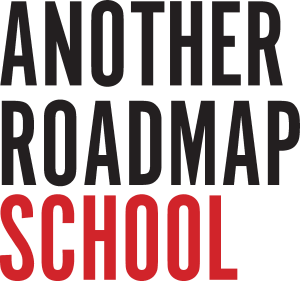Following the inaugural meeting of the Another Roadmap Africa Cluster in Uganda in 2015, Emma Wolukau-Wanambwa, who organised the meeting, sat down for an interview with Dominic Muwanguzi for
START Journal – Magazine for Contemporary Arts and Culture in East Africa.
The interview is reproduced here with the kind permission of the START JOURNAL editorial board.
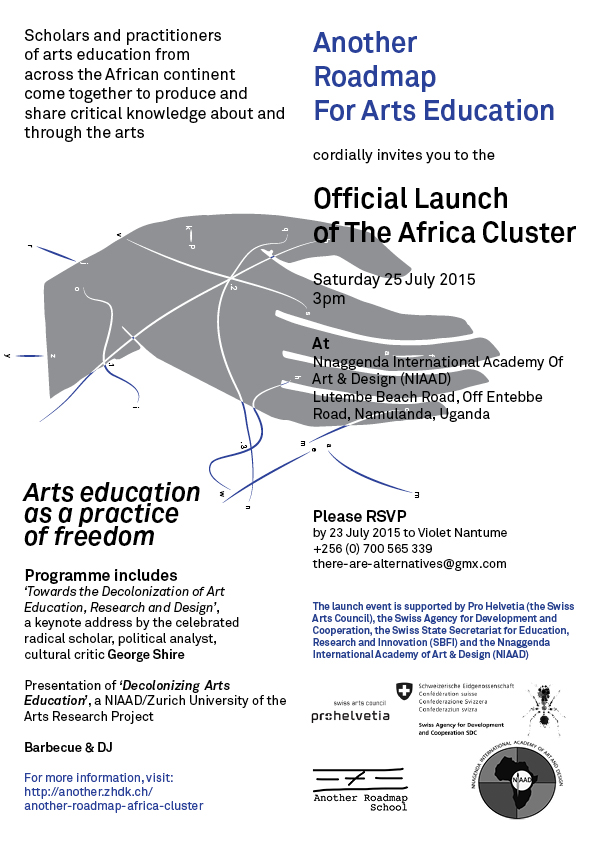
In July 2015 you were at the Nagenda International Academy of Art & Design (NIAAD) in Namulanda to launch the Another Roadmap Africa Cluster.
What is this project about?
The Another Roadmap Africa Cluster are a group of scholars and practitioners of artistic and cultural education, working across the African continent, who have come together to pursue a joint programme of research into arts educational practice in Africa that is critically informed and grounded in historical analysis. The group’s aim is to produce and to share knowledge about and through artistic and cultural education in Africa, and to make this knowledge available both across the continent and worldwide.
The Another Roadmap Africa Cluster will pursue a joint programme of research into arts education in Africa, focusing on 4 key areas:
-
Policy
: The analysis of policies and practices of arts education currently influential within various African contexts; -
Art Education Histories
: The assessment of the continuing hegemony of colonial westernized arts education in Africa; -
Other Roadmaps
: The plotting of alternatives and the development of other paradigms for practice and research in artistic education in Africa. -
Knowledge Transfer
: The research and development of strategies for making useful knowledges accessible and usable in our local contexts.
With this programme, the Another Roadmap Africa Cluster aims to make a lasting impact on arts education in Africa by creating a vibrant forum for exchange between Africa’s cultural scholars and practitioners and by producing research that is specifically targeted at Africa-based practitioners and policy makers.
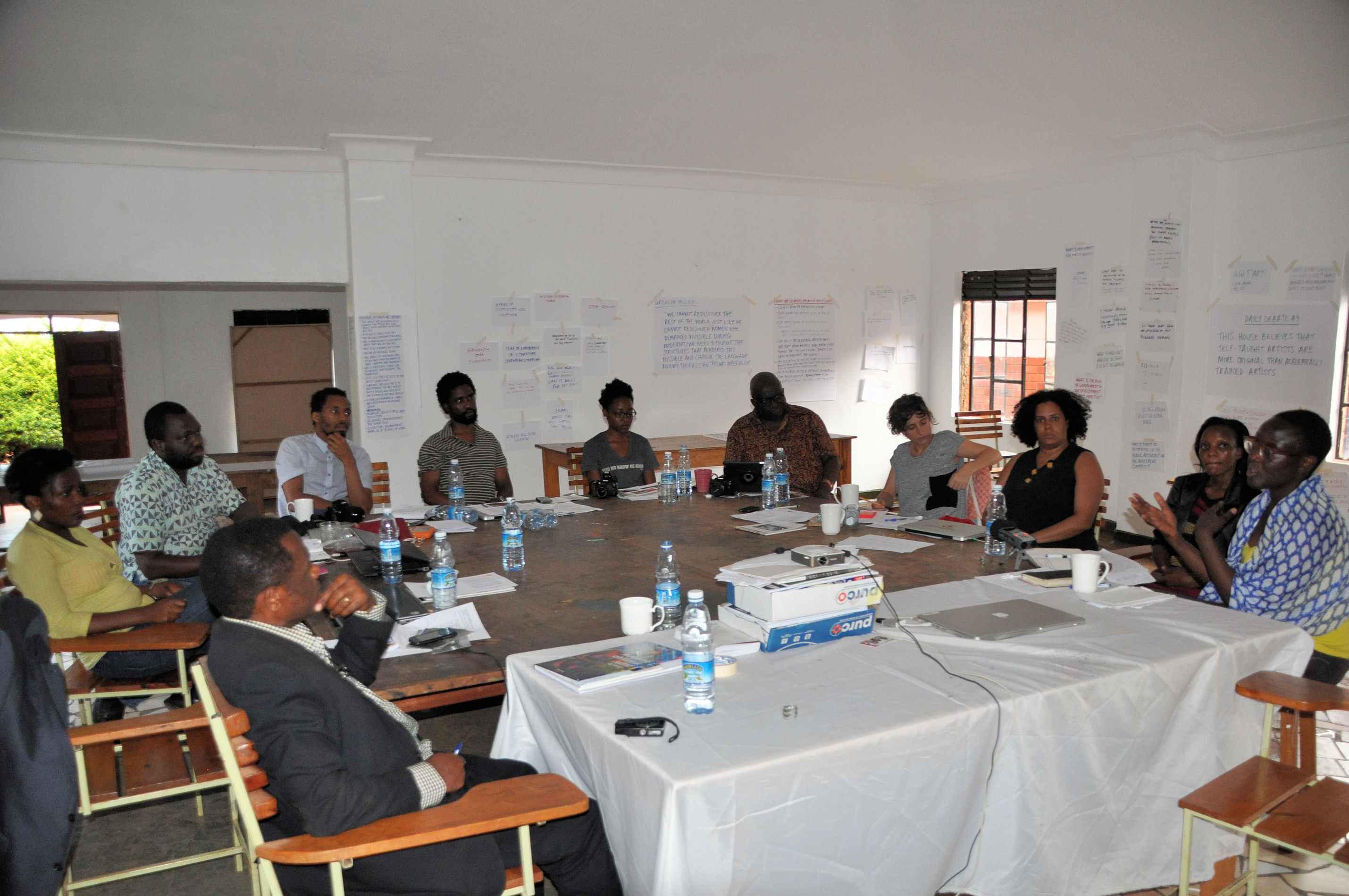
The idea to decolonize art education seems to me to be overly ambitious, especially in Uganda where one of the local languages, Luganda, was used as a tool of colonialism. Don’t you think this is a futile agenda?
I agree that it is ambitious to attempt to decolonize artistic education. But the scale of the challenge does not mean that it is not worth the attempt. Far from it: colonial power relations, and, in particular, the subordinate mentality that it, as a system, sought to instil in Africans, continues to impact decisively on relations of power, and on concepts of knowledge and value in ways that are perilously and generationally debilitating for far too many people on this continent.
A clear example of this is the extent to which European languages (admittedly for a complex range of reasons) continue to be widely used as what I once heard the Ghanaian academic Ato Quayson call the ‘languages of power’ in post-independence Africa. Indigenous African languages are regularly marginalized in law, in government, in journalism and in the education system within the very regions in which they originate. They are too rarely taken seriously by those with power as tools for serious discussion and debate. So-called “intelligent”people converse in the languages of former colonizers.
Immigrants settling in Africa from Europe and North America and their descendants can prosper here for generations without ever needing to acquire a proficient grasp of the languages of the people among whom they live. The obverse is decidedly untrue. In fact, it can get worse: last year I met the chairman of an internally displaced persons (IDP) camp on a beach on the shores of Lake Victoria, south of Mukono. He and his fellow fishermen were unfairly evicted from their homes on the islands in the lake ten years ago, and they have been fighting for redress ever since. When we met, the chairman of the camp expressed to me his belief that one of the main reasons that he has struggled to get anyone in the Ugandan government to pay serious attention to the plight of his community is because he cannot speak or write English. If this is true, then in this respect, this man is the victim of the colonial mentality of certain contemporary Ugandans.
The use of European languages might make the work and ideas of Africans more readily accessible to some foreigners, but it also limits the participation in discussion and decision-making of people who have not had access to formal European-style education. And ideas of such people should never automatically be dismissed as ignorant or irrelevant. People who don’t speak European languages, people who have had no formal European-style education also produce and preserve important and useful knowledges. Often indigenous knowledges. The dominance of European languages within African discourses can therefore restrict the access to and circulation of rich and valuable ideas, imaginaries, philosophies and world views.
So it’s a slow and difficult task, but part of what the Cameroonian theorist Achille Mbembe describes as ‘the difficult work of freedom’ in postcolonial Africa is, as I see it, to de-centre western cultures, western languages and western epistemologies, and to clear a space in which their indigenous counterparts can be reconstituted as centres of gravity.
And just because a particular indigenous culture or language group was implicated in colonial rule does not necessarily mean that that language or culture can play no role in emancipation. Some Baganda may have been complicit in British colonialism, but many others fought vehemently against it: Dr Kizito Maria Kasule, the founder of the Nagenda International Academy of Art & Design (NIAAD), which hosted the first meeting of the Another Roadmap School – Africa Cluster, is a Muganda from Masaka. The British sentenced his father to 5 years’ hard labour in the 1940s for his role in anti-colonial struggles in the Uganda Protectorate, an experience from which he never fully recovered.
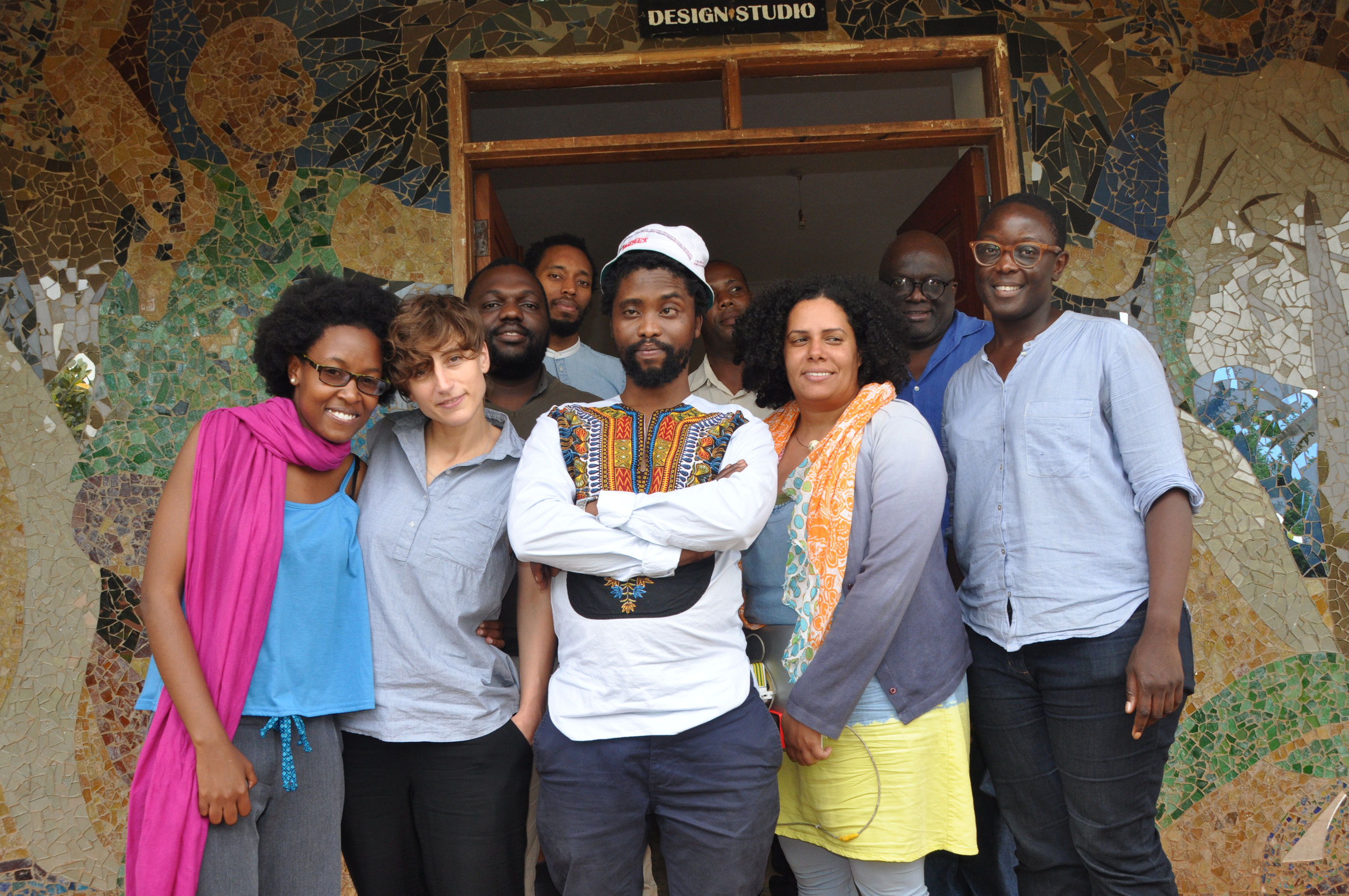
A project like this obviously encounters many challenges. What are some of those challenges you have already faced?
The Another Roadmap Africa Cluster has only very recently been constituted. We have faced relatively few challenges to date: so far, all of the institutions and individuals we have invited to participate have agreed to take part; we were able to raise just enough money to hold our first face-to-face meeting; a good sized audience of Uganda-based artists, arts practitioners and academics attended the launch event at NIAAD on 25 July. For the most part, our efforts and our ideas have been well received by scholars, practitioners, policy makers and funders with whom we have met. But we have not been lulled into a false sense of security. Far from it. The truth is that the real, the difficult work is still ahead of us – that is, doing the research, doing it well, and then persuading our peers of its value.
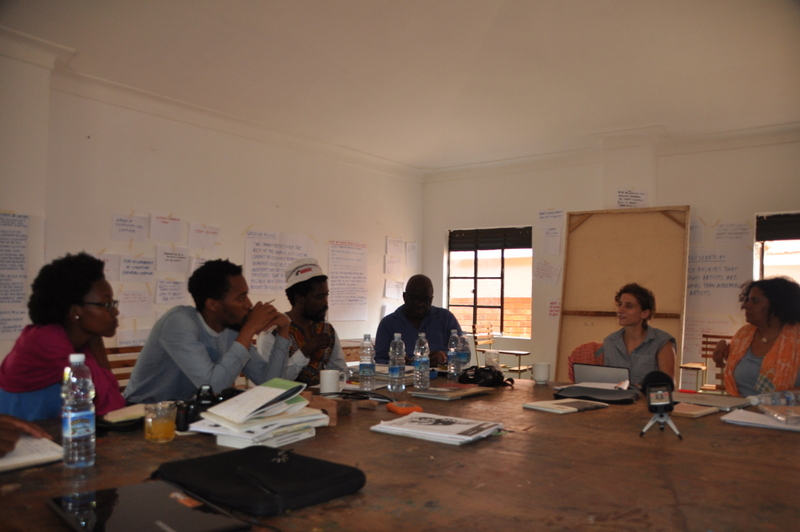
The conversation among many art elites on the continent today is about Pan African ideology in the arts. This can be seen with many workshops and exhibitions staged on the continent like the Art at Work Workshop, Artwork project, Dakar Biennale, the forthcoming Bamako Encounters and Kampala Art Biennale. Is this project part of the debate?
It largely depends on what you mean by ‘Pan-African ideology’. I personally understand and attempt to practice Pan-Africanism (more or less following Kwame Nkrumah), as an ideological and activist commitment to the solidarity of people of African origin both on the continent and in the diaspora, and to the idea that the unity of people of African origin is essential for Africa’s long-term economic, social, political and cultural progress.
I simply don’t know enough about the initiatives that you reference to be able to speak with any confidence about their Pan-African ‘credentials’. But it’s worth pointing out that just because an event brings Africans together does not necessarily make it Pan-African – strictly speaking. At the same time, and in this day and age, any such initiative nevertheless possesses that radical, emancipatory potential: one of the most serious colonial continuities to afflict post-independence Africa is that so many factors – often external factors – conspire to continue to make it difficult for Africans to meet, to exchange and to join forces. One simple example: it took longer and cost more money for Ayo Adewunmi to fly from Nigeria to Uganda to attend the first meeting of the Another Roadmap Africa Cluster in July on behalf of the Lagos Working Group than it would have taken him to fly to Europe. To me that is plain wrong.
It also depends on what you mean by ‘art elite’. I consider that to be a contentious and problematic term, particularly in the African context, where opportunities and resources are so unevenly distributed. There is a growing discontentment, about which your readers are no doubt aware, for example, regarding the extent to which influential global discourses on African art and the attendant opportunities for economic and social advancement tend to be dominated by artists and curators in the diaspora, who enjoy increased mobility, resources and greater access to wealthy western consumers and funders. I am well aware I could be said to fall into this category.
My individual identity/ status notwithstanding, I believe the Another Roadmap Africa Cluster to be borne of a commitment to the principles of Pan-Africanism that led to the foundation of the Organisation of African Unity (OAU) back in 1963. Like the OAU, its aims are also anti-elitist. The Another Roadmap Africa Cluster is a grassroots initiative that aims to support, develop and promote the work of Africa-based scholars and practitioners of artistic education from the bottom up. Although we ultimately hope to make a positive contribution at governmental and supranational policy level, we have no interest in being elitist per se.
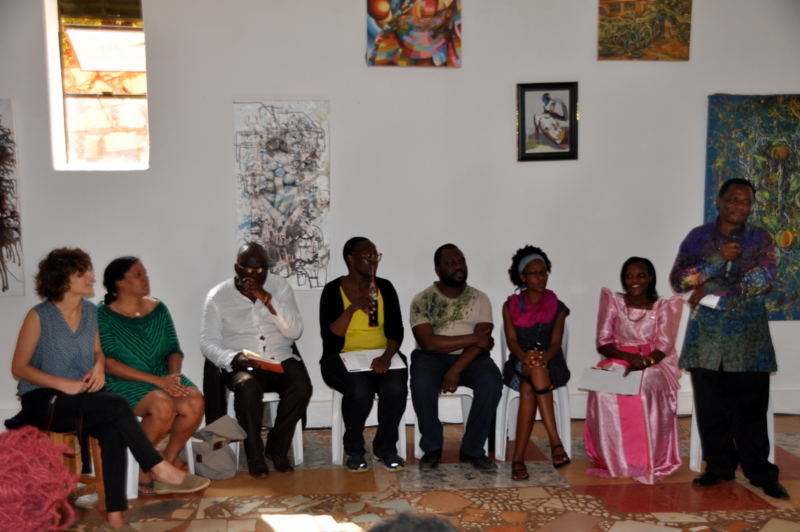
You are intensively involved in research. What have you been able to discover when it comes to the influence of western art education on art graduates on the continent today?
My own research into artistic education in Africa is still very much in its infancy and my knowledge is far from extensive. So at this point I can sadly only speak in crude generalizations. But what I do know is that the impact of western art education in Africa varies enormously according to the context.
It is extremely important to remember that ‘art’ and ‘education’ are neither self-evident nor universal concepts. Many aspects of the ‘symbolic creative work’ that is and has historically been practiced and transmitted within African societies does not fit neatly into western definitions of ‘art’, ‘education’ or ‘art education’. In many instances, under colonialism, such practices, where they were visible to colonisers, were devalued and systematically suppressed, often on the grounds of their supposed paganism or ‘impurity’. But some of these practices ‘flew under the radar’, so to speak, and have continued to flourish, largely free of the external imposition of western ideas. Other forms of indigenous symbolic creative work were, for complex and sometimes problematic reasons, positively endorsed and encouraged by colonisers. (This was often the case with music and dance in many African societies.). And still others, as is the case with figurative painting and sculpture in Uganda, were introduced into African societies by the colonisers themselves. And in many respects, those societies have, over time, made those imported art forms their own.
My current research focus is visual arts education in the Uganda Protectorate and in the subsequent republic. I am not in a position to speak with any authority about the influence of western art education on the teaching of music, dance, literature or drama, for example, anywhere on the continent – or, indeed, anywhere in the world. But what I have observed within visual arts education in Uganda/the Uganda Protectorate so far is that western models remain extremely dominant within formal education. When they were founded, most art schools in Anglophone Africa began by basing their curricula on those of pre-existing European and North American art academies, and this has not changed much in the post independence era – certainly not in Uganda.
I have also observed the western models that the major Ugandan art schools tend to follow are often highly fragmented, and frequently rather outdated. Conceptual art, multimedia and performance, for example, which have been well established features of western art schools curricula since the 1970s – and which, incidentally, have far, far deeper roots in East African cultures than figurative painting and sculpture – feature minimally in current formal Ugandan art curricula. African art histories continue to be marginalised within the teaching of art history, which remains largely Eurocentric, and consequently, to my mind, therefore, of questionable local relevance. In the informal sector, however, things tend to be quite different. But the informal sector is also much less likely to be influential on a policy level, and often has more fragile institutional infrastructure.
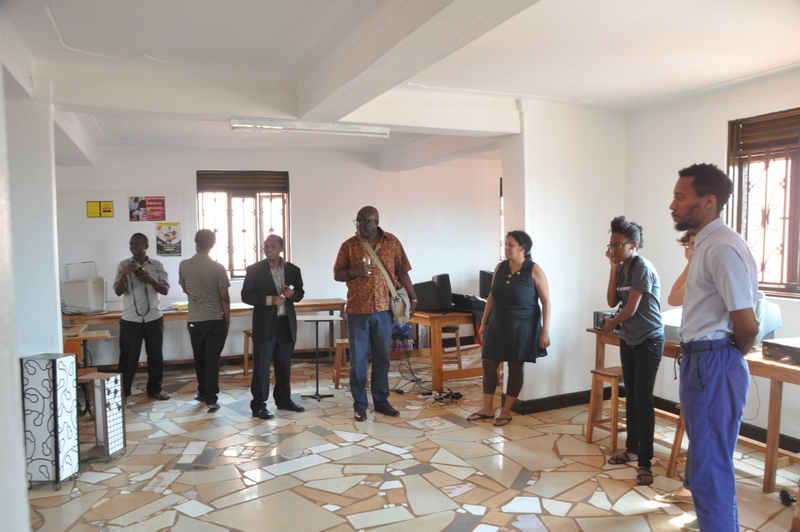
There is talk in some circles within the local art scene about opening up an art museum. What impact does such infrastructure have on art education and the overall growth of the art industry?
This is a complex question. The impact of museological infrastructure varies so much according to the context – on both historical and contemporary conditions.
In the case of Uganda, one of the ‘fractures’ or ‘disconnects’ that I observe in its dominant models of formal visual arts education is that, for historical reasons, its pedagogies construct concepts of value, and produce narratives about art and the artist’s trajectory are oriented by the idea of the museum. The museum serves as the arbiter of quality and legitimacy. The problem with this approach is that there is no art museum in Uganda, and very few art students ever have access to one during the course of their studies. So their education trains them to orient themselves and their work in relation to something that is largely abstract and wholly remote. To my mind, this does not make sense.
While I fully appreciate Ugandan artists’ desire to have a place to go locally to see art ‘properly’, it’s is not necessarily a problem, in my opinion, that there is no dedicated art museum in Uganda. Not only are museums notoriously expensive to maintain (and I am not persuaded that there is currently either the capital or the political will in this country for such a steep and open-ended investment), but the existence of the building is not in and of itself the solution. All over the world, museums are frequently empty and under-utilised: just because the place is there does not mean that people will use it. At the end of the day, it is good programming that will draw in an audience, and you don’t actually need a museum to run a rich and vibrant visual arts programme. In fact, in many cases, a building is a hindrance rather than a help.
I also question the appropriateness of the museum as form in Uganda. As institutions, museums evolved, in the western context, to place art at a remove from everyday life, framed by the aesthetic choices of social elites. This runs counter to what I know of the histories of cultural practice in this part of East Africa, where art has, for generations, been far more fully integrated into people’s everyday lives. To place art in a museum in Uganda would be to attempt to rarify it, and this would run counter to an aspect of local culture and tradition that I personally think is worth preserving and developing.
From my perspective it would be more helpful to focus on programming than on building. What would make the biggest difference to the quality of formal visual arts education in Uganda would be to devote more energies to fostering a local culture of exhibition-making (and exhibition-going), to create more vibrant, accessible and yet rigorous spaces where art can be discussed, critiqued and explored, and to place such activities at the heart of the visual arts curriculum.
While I am skeptical regarding the merits of establishing an art museum in Uganda, I do think there is one of a museum’s traditional activities that urgently needs to be invested in and institutionalised here, namely the collection and conservation of art works. Too few of the best examples of Ugandan art are held in local collections, too little of the work that is here is readily accessible to students and lecturers (hence the need for more exhibitions), and the conservation of that work can sometimes leave something to be desired. The tremendous efforts that the team at the Makerere University Art Gallery have made over the past few years to improve the conservation and documentation of its collection is very important in this respect. It shows how much can be achieved with determination, care and modest means. There need to be more initiatives like this, and we should work to create more opportunities for that and other Ugandan art collections to be seen, researched, debated and written about.
Another Roadmap Cluster to impact on art education on the continent- Q&A with Wolukau-Wanambwa
